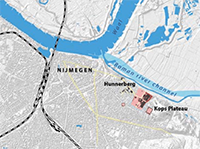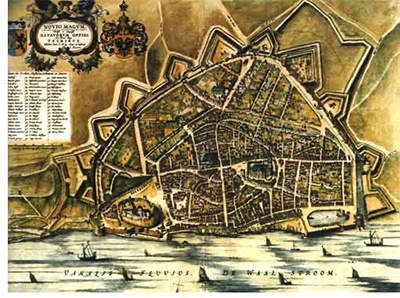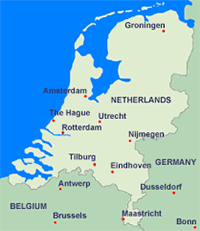Nijmegen: Oldest City in the Netherlands
Nijmegen is the oldest settlement in what is now the Netherlands, dating to early Roman times. 
Expanding northward in the first century B.C., Roman soldiers built a military camp on Nijmegen's current location. It was a spot that gave the army a commanding view of the surrounding territory, and the Romans rebuilt the settlement two centuries later, after a revolt by the neighboring Batavians. It was the emperor Trajan, in 104, who gave the town its familiar Roman name, Ulpia Noviomagus Batavorum. This was shortened to Noviomagus, in English New Market. With the decline of Roman influence in the area came an increase in prestige and influence of the Franks. The great Charlemagne kept a palace in Nijmegen in his time; then, it was named Numaga. The settlement gained city rights in 1230, courtesy of the Holy Roman Emperor Frederick II, whose father, Henry VI, had been born in Nijmegen six decades earlier. Permission granted, city leaders authorized the construction of extensive city walls. The city became part of Gelderland in 1247 and joined the guild and town confederation the Hanseatic League in 1364. 
Like other Dutch cities, Nijmegen flourished, its trade powered by travel along the Waal River, although its population had stabilized. It was about the same, 10,000, during the time of the Eighty Years War. The city joined the Uninon of Utrecht in 1579, breaking with Spain. Imperial troops occupied the city and then lost it famously during the siege of 1591. The 1678–9 Treaty of Nijmegen ended a handful of wars between various European powers, including the Third Anglo-Dutch War, during which French forces occupied the city for a time. French armies again were occupiers, taking the city in 1794, during the War of the First Coalition. France stripped Nijmegen of its capital city status, moving that designation to Arnhem. 
Nijmegen grew steadily into the 18th and 19th Centuries, its leaders introducing innovations such as the railroad and other trappings of the Industrial Revolution. One victim of this industrial progress was the destruction of the city's walls, long a system of protection against land-based attacks but unable to withstand the promise of modern weaponry. The city turned to expansion and modernization; with the absence of walls came the opportunity for geographical growth. One highlight in the between-World-Wars years was the construction of the Maas-Waal canal. Also about this time came the opening of the Radboud University. Nijmegen had avoided most of the operations of World War I. However, the German invasion in 1940 targeted Nijmegen initially, and the city fell to the Nazi blitzkrieg, which eventually claimed all of the Netherlands. Allied forces eventually liberated the city and the country, though not without extensive loss of life, particularly in an American bombing of the city that proved to be an accident and in one especially intense battle between Allied and Axis forces in September 1944. Allied armies liberated Nijmegen as part of Operation Market Garden and used the city as a springboard to an invasion of Germany the following year. The devastation of World War II created shortages in food, clothing, and shelter, and Nijmegen struggled more than other cities to create adequate housing for its population. As did many other European cities in the latter half of the 20th Century, Nijmegen recovered, its industry repowering a boom in construction and trade; this time, the city expanded more inwardly. In 2005, Nijmegen residents had a celebration marking 2,000 years of the settlement's existence. |
|
Social Studies for Kids
copyright 2002–2025
David White




